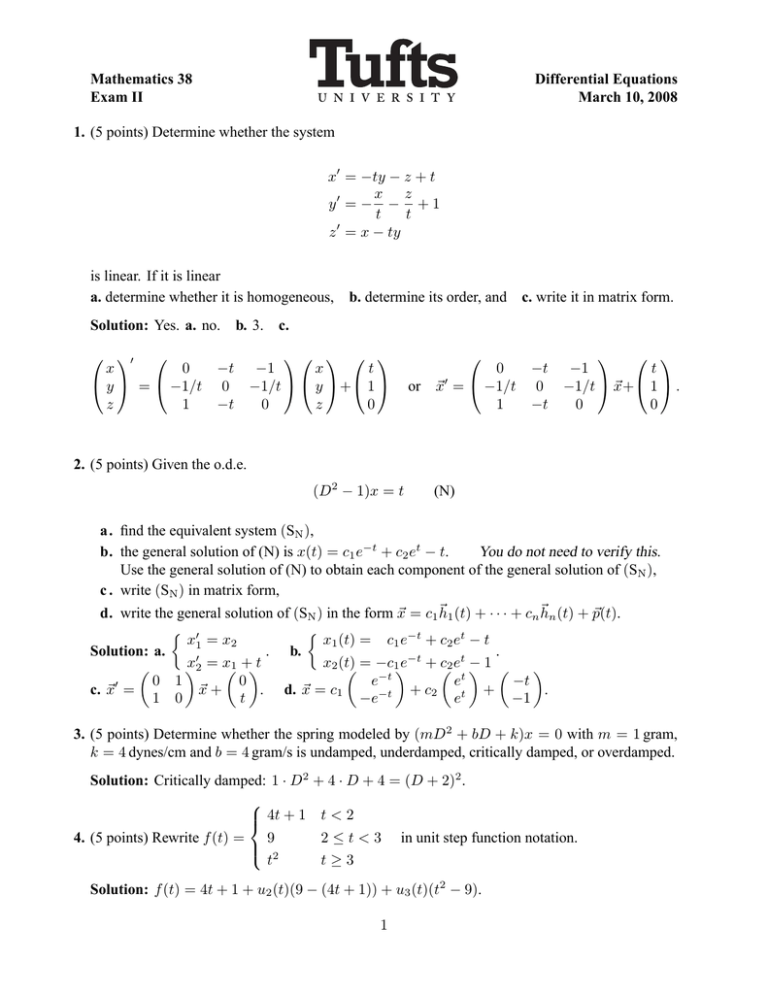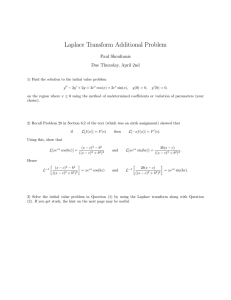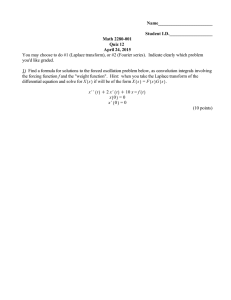
Mathematics 38
Exam II
Differential Equations
March 10, 2008
1. (5 points) Determine whether the system
x′ = −ty − z + t
x z
y′ = − − + 1
t
t
′
z = x − ty
is linear. If it is linear
a. determine whether it is homogeneous,
Solution: Yes. a. no.
′
0
x
y = −1/t
1
z
b. determine its order, and c. write it in matrix form.
b. 3. c.
−t
0
−t
t
x
−1
−1/t y + 1
0
z
0
0
or ~x′ = −1/t
1
−t
0
−t
t
−1
−1/t ~x + 1 .
0
0
2. (5 points) Given the o.d.e.
(D2 − 1)x = t
(N)
a. find the equivalent system (SN ),
b. the general solution of (N) is x(t) = c1 e−t + c2 et − t.
You do not need to verify this.
Use the general solution of (N) to obtain each component of the general solution of (SN ),
c . write (SN ) in matrix form,
d. write the general solution of (SN ) in the form ~x = c1~h1 (t) + · · · + cn~hn (t) + p~(t).
′
x1 = x2
x1 (t) = c1 e−t + c2 et − t
Solution: a.
.
b.
.
′
−t
t
x
=
x
+
t
x
(t)
=
−c
e
+
c
e
−
1
1
2
1
2
2
−t t 0
e
0 1
e
−t
′
. d. ~x = c1
~x +
+ c2
c. ~x =
.
+
t
−e−t
1 0
et
−1
3. (5 points) Determine whether the spring modeled by (mD2 + bD + k)x = 0 with m = 1 gram,
k = 4 dynes/cm and b = 4 gram/s is undamped, underdamped, critically damped, or overdamped.
Solution: Critically damped: 1 · D2 + 4 · D + 4 = (D + 2)2 .
4t + 1 t < 2
4. (5 points) Rewrite f (t) =
9
2 ≤ t < 3 in unit step function notation.
2
t
t≥3
Solution: f (t) = 4t + 1 + u2 (t)(9 − (4t + 1)) + u3 (t)(t2 − 9).
1
5. (10 points)
a. Make a simplified guess for a particular solution of (D2 − 2D + 1)x = tet .
You do not need to determine the coefficients!
Solution: k1 t2 et + k2 t3 et .
√
b. Find the general solution of (D2 − 2D + 1)x = et t
for t > 0.
Solution:
c′1 (t)et + c′2 (t)et t
=0
√
c′1 (t)et + c′2 (t)et (t + 1) = tet
simplifies to
c′1 (t) + c′2 (t)t = 0
√
c′2 (t) = t,
which gives c′1 (t) = −t3/2 and c′2 (t) = t1/2 and the general solution c1 et + c2 tet +
4 5/2 t
t e.
15
6. (10 points)
a. Compute L [e5t+3 ] using the definition. No credit by any other method
b. State for which values of s this Laplace transform is defined.
Z ∞
Z h
e3
e3
−st 5t+3
3
lim [e−(s−5)h − 1] =
Solution:
e e
dt = lim e
e−(s−5)t dt = −
h→∞
s − 5 h→∞
s−5
0
0
for s > 5.
7. (10 points) Find 1 ∗ cos 5t.
Z t
Solution:
1 · cos 5u du = (1/5)[sin 5u]t0 = (1/5) sin 5t.
0
8. (10 points) Find the Laplace transform of f (t) = te5t sin 3t.
Solution: L [t sin 3t] = −
6s
6(s − 5)
3
d
= 2
, so L [te5t sin 3t] =
.
2
2
ds s + 9
(s + 9)
((s − 5)2 + 9)2
9. (20 points) Find the inverse Laplace transform of
s+3
a. 2
.
s + 4s + 5
Solution: L −1 [
b.
s2
(s + 2) + 1
s+1
s+3
] = L −1 [
] = e−2t L −1 [ 2
] = e−2t (cos t + sin t).
2
+ 4s + 5
(s + 2) + 1
s +1
s
.
(s2 + 5)2
Solution: L −1 [
√
√
√
s
1
1
t
s
−1
√
√
sin
sin
]
=
L
[
·
]
=
cos
5t∗
5t
=
5t.
(s2 + 5)2
(s2 + 5) (s2 + 5)
5
2 5
2
10. (20 points) Solve using the Laplace transform. No credit by any other method.
a. x′′ + 4x′ + 4x = t2 e−2t ,
x(0) = x′ (0) = 0.
2
1 4 −2t
2
, so L [x] =
and x =
t e .
Solution: (s + 2)2 L [x] = L [t2 e−2t ] =
3
5
(s + 2)
(s + 2)
12
2
t
t<2
b. (D − 1)x =
,
x(0) = 1.
2
t +1 t≥2
Solution: (s − 1)L [x] − 1 = L [t2 ] + L [u2 (t)] =
L [x] =
2
2
e−2s
−2s
, so
+
e
L
[1]
=
+
s3
s3
s
2
e−2s
1
+ 3
+
.
s − 1 s (s − 1) s(s − 1)
Now do partial fractions decompositions: setting
1
A
B
C
E
= + 2+ 3+
− 1)
s
s
s
s−1
s3 (s
gives
As2 (s−1)+Bs(s−1)+C(s−1)+Es3 = 1 or
A+E = 0, B −A = 0, C −B = 0, −C = 1,
giving C = −1, B = −1, A = −1, and E = 1. Similarly, set
A
B
1
= +
,
s(s − 1)
s
s−1
giving A(s − 1) + Bs = 1, or A = −1, B = 1.
So,
2
e−2s
1
+
+
x(t) = L
s − 1 s3 (s − 1) s(s − 1)
1
1
1
1
−1 −1
t
−1 −1
− 2− 3+
+
+ u2 (t)L
(t − 2)
= e + 2L
s
s
s
s−1
s
s−1
t2
t
t
= e + 2 −1 − t − + e + u2 (t) −1 + et−2
2
= 3et − 2 − 2t − t2 − u2 (t) 1 − et−2 .
−1
END OF EXAMINATION
©2010 Trustees of Tufts College. All rights reserved.



